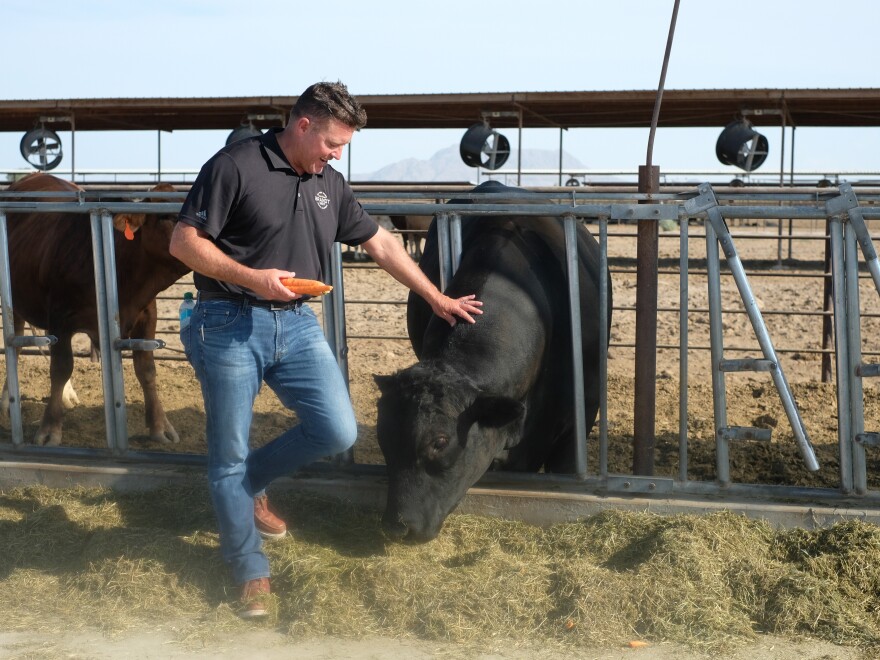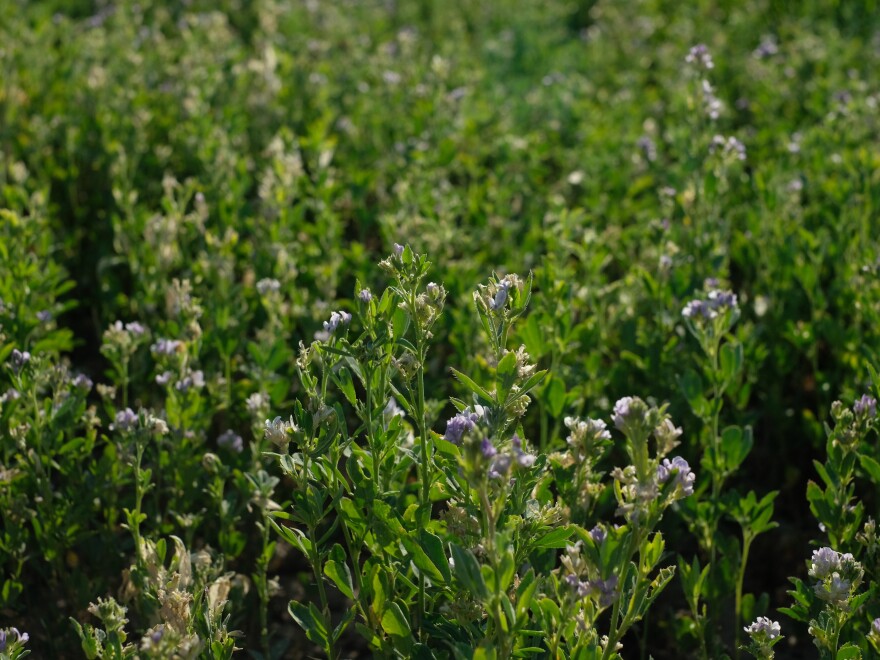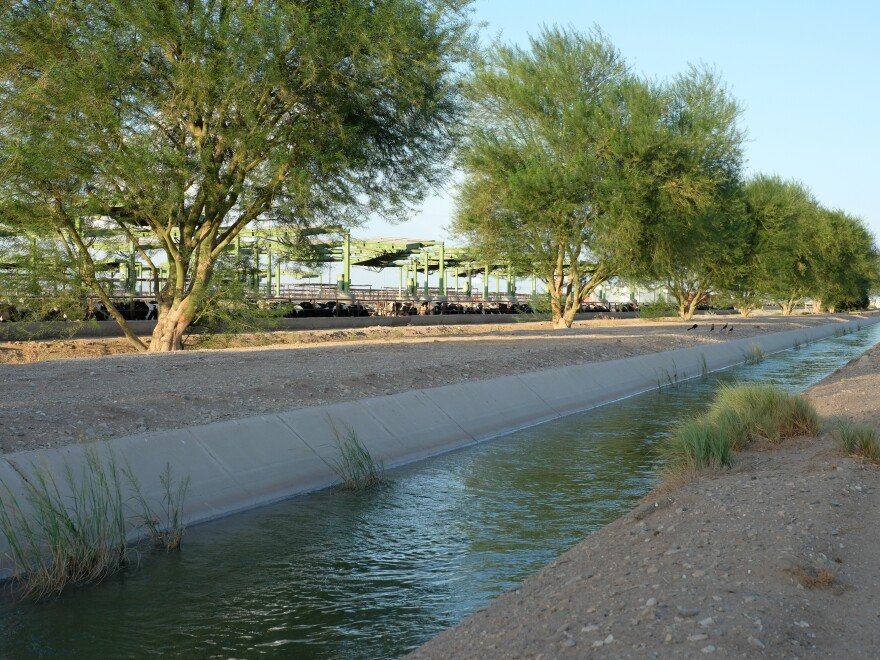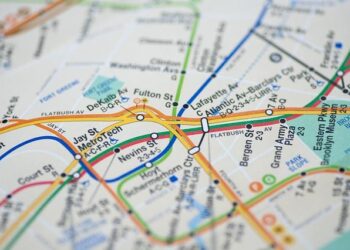Erin Stone / LAist
/
LAist
Hay grown from Colorado River water in the Imperial Valley. In the background is a farm field converted to solar panels. Taking farmland out of production for solar panels is a growing trend in the Imperial Valley to save water and generate clean power for cities. But many farmers say the strategy hurts the local economy.
Alfalfa, on the other hand, is largely harvested by machine. ItтАЩs more resilient to drought. And it can be sold pretty much year-round.
But the Imperial Valley is a desert. Farming alfalfa here requires about as much water as the entire state of Arizona is allocated per year from the Colorado River.
It may sound counterintuitive to farm in the desert, says Paul Brierley, director of the Arizona Department of Agriculture and former director of the University of ArizonaтАЩs Yuma Center of Excellence for Desert Agriculture.
But he says the soil in this part of the Colorado River basin is very fertile. Before the river was diverted to cities and farms, it flooded this region for thousands of years on its way to the sea, building up layers of nutrient-rich sediment.
Plus, with year-round sunshine and little rain, itтАЩs possible to grow more food and there are fewer variables that could ruin a crop.
тАЬI like to say we farm in the desert not in spite of the desert, but because of the desert,тАЭ Brierley says. тАЬIt turns out that we have, in most crops, really the highest productivity per acre and per acre-foot of water that you get anywhere тАФ even alfalfa.тАЭ
Tagg and his neighbors are intimately aware of changes on the Colorado River.
тАЬWe’re probably more conscientious than anybody because we’re directly related to the river, as opposed to, with all due respect, someone who just turns on a tap or waters their lawn,тАЭ Tagg says.
But the way farmers receive water in the Imperial Valley, through a system of canals drawing from the Colorado River, is more like turning on the tap than in other regions. Higher up in the riverтАЩs basin, like in Colorado, farmers and ranchers go out of business if streams and wells run dry.
And Imperial Valley farmers such as Tagg are first in line to get Colorado River water. They have senior legal rights to the river, so they get the biggest bucket of water тАФ and theyтАЩre the last to face cuts.
But Tagg says stricter water limits are starting to change his business.
ItтАЩs one reason heтАЩs prepping some of his land to grow less-water-intensive onions, instead of alfalfa.
тАЬObviously it’s better for our ranch to have more diversification, different revenue streams, but we’re also creating a way for us to conserve water,тАЭ Tagg says.

Erin Stone / LAist
/
LAist
The irrigation gate of the Acacia Canal in the Imperial Valley near El Centro delivers Colorado River water to TaggтАЩs fields and other farms. The Colorado River is the only source of water for the Imperial Valley.
HeтАЩs also invested in pipe irrigation, which uses less water than traditional flood irrigation but is more expensive to install. He was able to recoup about half of the roughly $5 million heтАЩs spent on pipes through state grants.
At times, Tagg sublets alfalfa plots to farmers who specialize in other vegetables that use less water, like carrots. That crop rotation makes for healthier soil, he says, which also needs less water. Such crop rotation partnerships are becoming more common in the area, Tagg says.
Federal policy is also making that bet more attractive.
Tagg plans to participate in a new program in the Imperial Valley, in which the federal government will pay him not to grow alfalfa and other hay crops during the driest months of the year. ItтАЩs part of a major deal recently struck with the U.S. Bureau of Reclamation. Imperial Valley farmers agreed to cut their water use through 2026, with cuts adding up to more than twice as much as the entire state of Nevada uses in a year.

Erin Stone / LAist
/
LAist
Eric Brandt runs a 125-acre organic beef ranch near El Centro in the Imperial Valley. HeтАЩs part of one of the regionтАЩs largest farming families, which receives significant allocations of Colorado River water. He says farmers and ranchers in the region are becoming increasingly efficient at using less water.
Meeting the demand for beef and dairy
The Imperial Valley isnтАЩt just home to hay crops like alfalfa. There are also hundreds of thousands of cows.
Eric Brandt runs a 125-acre, grass-fed cattle ranch, raising some 250 beef cattle and selling mostly to high-end organic markets in the U.S. His brother grows alfalfa, and his dad runs a larger ranch nearby. The family is among the biggest users of Colorado River water in the valley.
The regionтАЩs cattle ranchers argue that as global demand for beef grows, itтАЩs better to raise beef in places like the Imperial Valley than in parts of the world with more lax regulations, such as Brazil, where cattle ranching is a major driver of deforestation.
тАЬYou’re not going to change demand, it’s just going to come from other sources that you don’t have the ability to regulate,тАЭ Brandt says.
He points to efforts to mitigate the environmental impact of farming in the Imperial Valley. On BrandtтАЩs 125-acre ranch, the cowsтАЩ manure is used as compost on alfalfa fields, which helps lessen the use of fertilizers derived from fossil fuels and helps reduce water use. They recently received a permit to recycle water used at their beef processing plant to meet water restrictions.
тАЬWould you rather consume beef or American products,тАЭ Brandt asked, тАЬversus importing beef or produce from other countries that don’t share the same values and don’t have the same regulations, that might be deforesting land?тАЭ

Erin Stone / LAist
/
LAist
Alfalfa seed grows in the Imperial Valley of Southern California.
Producers like Brandt and Tagg say that instead of pointing the finger at farmers, part of the solution is for consumers to better understand where their food comes from.
Small dietary changes, big impact
Climate scientists say the current global appetite for beef and dairy is unsustainable in the long term, but even modest changes could have a major impact.
Beef demand is rising around the world. In the U.S., per capita beef consumption has leveled off. But AmericansтАЩ growing demand for dairy products like yogurt and cheese is driving demand for more alfalfa in the Colorado River basin, says Brian Richter, the lead author of the study on Colorado River water use.
The rising global demand for beef and dairy products means there are now so many cows on the planet that theyтАЩve become a major source of greenhouse gas emissions.
Through their burps, farts and manure, cows are the largest source of methane emissions in the U.S. and the the world. Methane is a greenhouse gas thatтАЩs heating up the planet even faster than carbon dioxide.
The U.S., which has the fourth-largest cattle population in the world, plays a role in reducing that demand, says Jessica Fanzo, director of the Food for Humanity Initiative and a professor who studies climate and diet at Columbia University.
тАЬIf you look at the countries who emit the most greenhouse gases from their food system, it’s the United States, Brazil, China, Indonesia, the EU and India,тАЭ Fanzo says. тАЬ[Red meat] is quite cheap in the U.S. It’s culturally normal. It’s almost hard to not eat meat.тАЭ
Americans consume more meat and dairy than most people across the globe, and above the recommended amount for good health, Fanzo says.
тАЬIn places like the United States, we have a lot of room to move. We can reduce our meat consumption and still be very healthy,тАЭ she says.
Researchers stress that small changes in eating habits can add up and make a big impact.
In general, Fanzo says, a good rule of thumb for a climate-friendly diet is to eat more plants and plant-based foods and less red meat and dairy.
тАЬI don’t think everyone has to become a vegan or even vegetarian,тАЭ Fanzo says. тАЬIt’s this reducing.тАЭ
One strategy is to skip beef at breakfast and lunch and instead get your protein in other ways, Fanzo says, such as with canned beans, oysters or sardines. She suggested making eating beef a special occasion.

Erin Stone / LAist
/
LAist
A canal of Colorado River water in the Imperial Valley runs beside a cattle feedlot.
Eating more vegetables would also help, says Brierley, the director of the Arizona Department of Agriculture.
If more Americans chose diets better aligned with federal health recommendations, he says, that could help shift the market to less-water-intensive and lower-emission vegetable crops.
тАЬI’ve had produce growers say, even if people would get just a little bit closer to what they’re supposed to as far as number of servings a day of vegetables, it would really spur demand and more people would switch to growing produce,тАЭ Brierley says.
Diets are personal тАФ theyтАЩre connected to cultures, individual health and tastes, as well as how much money and time households have.
But when enough people make a few changes in their individual lives тАФ and support policies and farmers that produce food more sustainably тАФ experts say it can lead to significant large-scale shifts down the line.
тАЬClimate change is daunting, but you can make changes that do matter,тАЭ Fanzo says. тАЬAs climate change continues to barrel down on us, and people learn about the connection that food is contributing to climate тАФ and livestock is one of the big issues in the food space тАФ I think more people will come to the table.тАЭ
Copyright 2024 LAist 89.3
Source link : http://www.bing.com/news/apiclick.aspx?ref=FexRss&aid=&tid=66e1cc3af51b48d389326b518f5ba881&url=https%3A%2F%2Fwww.iowapublicradio.org%2Fnews-from-npr%2F2024-09-11%2Fcan-eating-less-beef-and-dairy-help-save-the-colorado-river&c=1925067354972379375&mkt=en-us
Author :
Publish date : 2024-09-11 05:00:00
Copyright for syndicated content belongs to the linked Source.












